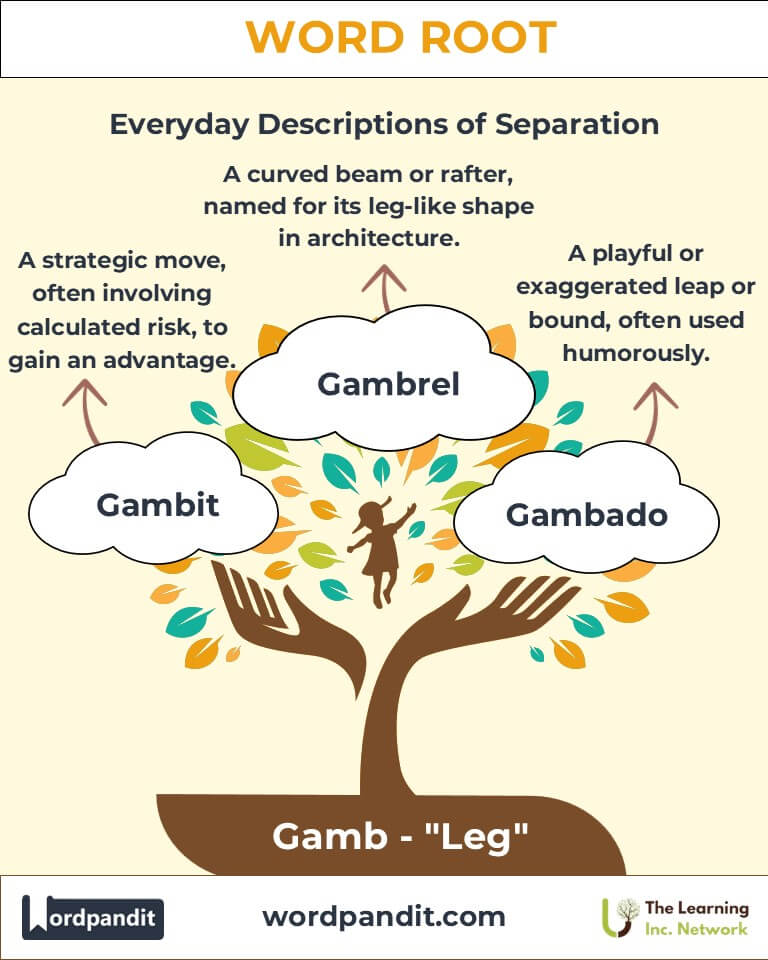Gamb: The Leg Root of Movement and Strategy in Language
Explore the linguistic journey of "gamb," a root signifying "leg," as it strides through history and language. From strategic terms like "gambit" to evocative descriptions like "ingambe," this root reflects agility, movement, and readiness across multiple contexts.

Table of Contents
- Introduction: The Essence of "Gamb"
- Etymology and Historical Journey
- Mnemonic: Unlocking the Power of "Gamb"
- Common "Gamb"-Related Terms
- "Gamb" Through Time
- "Gamb" in Specialized Fields
- Illustrative Story: "Gamb" in Action
- Cultural Significance of the "Gamb" Root
- The "Gamb" Family Tree
- FAQs About the "Gamb" Word Root
- Test Your Knowledge: "Gamb" Mastery Quiz
- Conclusion: The Living Legacy of "Gamb"
Introduction: The Essence of "Gamb"
What do a strategic chess move and an agile, healthy posture have in common? Both derive from the root "gamb," meaning "leg." Originating from Italian and Latin influences, this root captures the essence of motion, readiness, and strategy. Its significance has leaped into various fields, from gaming to anatomy, showcasing the versatility of this limb-inspired root.

Etymology and Historical Journey
The root "gamb" traces back to the Italian "gamba," meaning "leg," itself derived from the Late Latin "gamba," used to describe the leg or shank of an animal. The term transitioned into Old French and Middle English, evolving both literally and metaphorically to denote physical agility and strategic advantage.
Mnemonic: Unlocking the Power of "Gamb"
Picture a chessboard where each piece is a runner, using their legs to make calculated strides. The root "gamb" connects the physicality of legs with the mental agility required for strategy.
Mnemonic Device: “Gamb’s gambit is movement—legs lead the way to strategy and agility.”
Common "Gamb"-Related Terms
- Gambit (pronounced gam-bit):
- Definition: A strategic move, often involving calculated risk, to gain an advantage.
- Example: "The politician’s speech was a bold gambit to win public support."
- Ingambe (pronounced in-gahm):
- Definition: Lively or nimble; physically agile (borrowed from Italian).
- Example: "Despite his age, the dancer remained remarkably ingambe."
- Gambrel (pronounced gam-bruhl):
- Definition: A curved beam or rafter used in construction, named for its leg-like shape.
- Example: "The barn’s gambrel roof stood out against the skyline."
- Gambado (pronounced gam-bah-doh):
- Definition: A leap or bound, often playful or exaggerated.
- Example: "The actor’s gambados added humor to the performance."
"Gamb" Through Time
• Early Usage:
The term “gamb” initially referred to physical legs or appendages in medieval anatomy.
• Modern Shift:
By the Renaissance, its metaphorical usage expanded, with "gambit" entering chess terminology to denote strategic plays.
"Gamb" in Specialized Fields
1. Chess and Strategy:
Gambit: Opening moves designed for tactical advantage, embodying foresight and risk.
2. Anatomy and Physicality:
Ingambe: Referring to physical vitality, used in medical or descriptive contexts.
3. Architecture:
Gambrel: The leg-like curvature of this structure influenced its name, illustrating how physical forms inspire design.
Illustrative Story: "Gamb" in Action
In a bustling marketplace, Marco, a street performer, captured the crowd’s attention with his gambados—leaps and bounds that defied gravity. Inspired by his agility, a young chess enthusiast used her first gambit to outmaneuver her opponent in a local tournament. Both Marco and the chess player showcased the spirit of "gamb": movement and strategic brilliance.
Cultural Significance of the "Gamb" Root
The root "gamb" reflects humanity’s admiration for mobility and strategic foresight. Its presence in art, games, and language highlights our reliance on physical and mental agility. From ballet leaps to boardroom gambits, "gamb" underscores the universal value of calculated movement.

The "Gamb" Family Tree
- Ped (Latin: foot):
- Pedestrian: Relating to walking.
- Pedal: A foot-operated lever.
- Grad (Latin: step):
- Graduate: To move up a step in education or rank.
- Gradual: Progressing step by step.
- Amb (Latin: walk):
- Ambulate: To walk.
- Ambulance: Originally referring to mobile medical care.
FAQs About the "Gamb" Word Root
Q: What does "gamb" mean?
A: "Gamb" is a root that means "leg." It originates from the Italian "gamba" and the Late Latin "gamba," referring to the leg or limb of an animal. Over time, it has evolved to convey ideas of movement, agility, and strategy, reflecting both physical and metaphorical applications.
Q: What is a gambit in chess?
A: A gambit is a strategic opening move in chess where a player sacrifices a pawn or another piece to gain a positional or tactical advantage. The term highlights the connection between "gamb" and calculated risk-taking, akin to stepping forward boldly to seize control.
Q: Is "ingambe" commonly used in English?
A: "Ingambe" is a borrowed term from Italian and is relatively rare in English. It describes someone who is lively, agile, or physically vigorous, often used in poetic or descriptive contexts to emphasize vitality or readiness.
Q: What is a gambrel roof?
A: A gambrel roof is a type of roof with two slopes on each side, where the lower slope is steeper than the upper one. Its name comes from the curved shape resembling the hind legs of a horse or other animals, connecting to the root "gamb" (leg).
Q: What does "gambado" mean, and how is it used?
A: "Gambado" refers to a playful or exaggerated leap or bound. It can describe theatrical or humorous movements, often used in performances or literature to depict joy, excitement, or spontaneity.
Test Your Knowledge: "Gamb" Mastery Quiz
1. What does the root "gamb" signify?
2. What is a gambit?
3. What does "ingambe" describe?
4. Which field uses the term "gambrel"?
5. What is a gambado?
Conclusion: The Living Legacy of "Gamb"
The root "gamb" strides through language with elegance and versatility, connecting physical movement to intellectual strategy. From the literal agility of a dancer to the calculated moves of a chess player, its presence in words like "gambit" and "ingambe" reflects our dynamic interplay of action and thought. Let "gamb" inspire you to take confident steps toward your goals, both literal and metaphorical.












